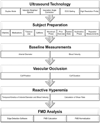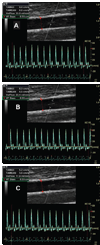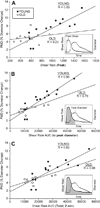Ultrasound assessment of flow-mediated dilation
- PMID: 20351340
- PMCID: PMC2878744
- DOI: 10.1161/HYPERTENSIONAHA.110.150821
Ultrasound assessment of flow-mediated dilation
Abstract
Developed in 1992, the flow-mediated dilation test is now the most commonly used noninvasive assessment of vascular endothelial function in humans. Since its inception, scientists have refined their understanding of the physiology, analysis, and interpretation of this measurement. Recently, a significant growth of knowledge has added to our understanding and implementation of this clinically relevant research methodology. Therefore, this tutorial provides timely insight into recent advances and practical information related to the ultrasonic assessment of vascular endothelial function in humans.
Figures




Similar articles
-
Endothelial reactivity and cardiac risk factors in older patients with peripheral arterial disease.Am J Cardiol. 1999 Mar 1;83(5):754-8. doi: 10.1016/s0002-9149(98)00984-9. Am J Cardiol. 1999. PMID: 10080432
-
Effect of cardiac cycle on ultrasound assessment of endothelial function.Vasc Med. 2002 May;7(2):103-8. doi: 10.1191/1358863x02vm425oa. Vasc Med. 2002. PMID: 12402990 Clinical Trial.
-
New assessment of endothelial function measured by short time flow-mediated vasodilation: Comparison with conventional flow-mediated vasodilation measurement.Int J Cardiol. 2018 Aug 15;265:24-29. doi: 10.1016/j.ijcard.2018.05.006. Epub 2018 May 4. Int J Cardiol. 2018. PMID: 29754930
-
Flow-mediated vasodilation: a diagnostic instrument, or an experimental tool?Chest. 2005 Jun;127(6):2254-63. doi: 10.1378/chest.127.6.2254. Chest. 2005. PMID: 15947345 Review.
-
[Non-invasive evaluation of the endothelial function using high-resolution B-mode ultrasonography].Ital Heart J Suppl. 2001 Nov;2(11):1155-60. Ital Heart J Suppl. 2001. PMID: 11775406 Review. Italian.
Cited by
-
Impacts of prolonged sitting with mild hypercapnia on vascular and autonomic function in healthy recreationally active adults.Am J Physiol Heart Circ Physiol. 2020 Aug 1;319(2):H468-H480. doi: 10.1152/ajpheart.00354.2020. Epub 2020 Jul 10. Am J Physiol Heart Circ Physiol. 2020. PMID: 32648821 Free PMC article.
-
Improved vascular function and functional capacity following l-citrulline administration in patients with heart failure with preserved ejection fraction: a single-arm, open-label, prospective pilot study.J Appl Physiol (1985). 2023 Feb 1;134(2):328-338. doi: 10.1152/japplphysiol.00445.2022. Epub 2022 Dec 8. J Appl Physiol (1985). 2023. PMID: 36476159 Free PMC article. Clinical Trial.
-
Vascular smooth muscle function: defining the diabetic vascular phenotype.Diabetologia. 2013 Oct;56(10):2107-9. doi: 10.1007/s00125-013-3008-8. Epub 2013 Aug 2. Diabetologia. 2013. PMID: 23907382
-
Short-term unilateral leg immobilization alters peripheral but not central arterial structure and function in healthy young humans.Eur J Appl Physiol. 2011 Feb;111(2):203-10. doi: 10.1007/s00421-010-1636-y. Epub 2010 Sep 18. Eur J Appl Physiol. 2011. PMID: 20852882 Clinical Trial.
-
Tracking peripheral vascular function for six months in young adults following SARS-CoV-2 infection.Physiol Rep. 2022 Dec;10(24):e15552. doi: 10.14814/phy2.15552. Physiol Rep. 2022. PMID: 36541342 Free PMC article.
References
-
- Celermajer DS, Sorensen KE, Gooch VM, Spiegelhalter DJ, Miller OI, Sullivan ID, Lloyd JK, Deanfield JE. Non-invasive detection of endothelial dysfunction in children and adults at risk of atherosclerosis. Lancet. 1992;340:1111–1115. - PubMed
-
- Uehata A, Lieberman EH, Gerhard MD, Anderson TJ, Ganz P, Polak JF, Creager MA, Yeung AC. Noninvasive assessment of endothelium-dependent flow-mediated dilation of the brachial artery. Vascular Medicine. 1997;2:87–92. - PubMed
-
- Anderson TJ, Uehata A, Gerhard MD. Close relationship of endothelial function in the human coronary and peripheral circulations. J Am Coll Cardiol. 1995;26:1235–1241. - PubMed
-
- Corretti MC, Anderson TJ, Benjamin EJ, Celermajer D, Charbonneau F, Creager MA, Deanfield J, Drexler H, Gehard-Herman M, Herrington D, Vallance P, Vita J, Vogel R. Guidelines for the Ultrasound Assessment of Endothelial-Dependent Flow-Mediated Vasodilation of the Brachial Artery. J Am Coll Cardiol. 2002;39:257–265. - PubMed
-
- Celermajer DS, Sorensen KE, Gooch VM. Non-invasive detection of endothelial dysfunction in children and adults at risk of atherosclerosis. Lancet. 1992;340:1111–1115. - PubMed
Publication types
MeSH terms
Substances
Grants and funding
LinkOut - more resources
Full Text Sources
Other Literature Sources
Medical

